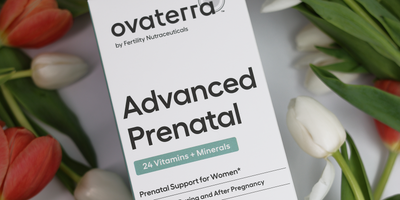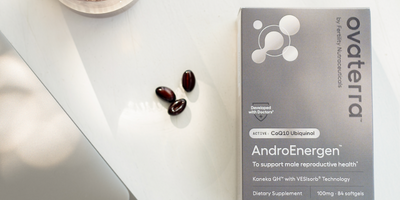Choosing the right ovulation tracker is key
You know you want to start tracking your ovulation, but are overwhelmed with different options? You’ve come to the right place! There are quite a few options to test and track ovulation, and depending on your situation, some will be a better fit than others. Here are the 5 main factors to consider when looking for the ovulation tracker that best fits your needs.
What to consider when choosing ovulation trackers
Tracking ovulation and knowing your fertile window is one of the most impactful things you can do on your journey. To help you narrow down the choices, Ovaterra’s scientific team independently evaluated and recommends 4 ovulation trackers:
- kegg Fertility Tracker
- Tempdrop Fertility Monitor
- Proov Predict & Confirm Kit
- Oova Ovulation Tracking Kit
While we are confident that these “next-gen” trackers are all great at what they do, which one works best will depend on these 5 factors about you.
1. What's your age?
Your age impacts your decision in two ways. First, for women in their late 30s and into their 40s, some ovulation trackers that measure LH levels may be more difficult to interpret the results. It’s because LH levels of women 35+ tend to be elevated throughout the cycle, making it hard to spot the LH surge that signals approaching ovulation.
From this point of view, ovulation trackers based on cervical mucus or basal body temperature (BBT) may be a better fit for women 40+. Among the 4 ovulation trackers our scientific team recommends, kegg Fertility Tracker and Tempdrop Fertility Monitor fit the bill here.
Your age may also affect your cost-benefit analysis on ovulation trackers. On a population level, younger women get pregnant more quickly than women in their late 30s and into the 40s. So, ovulation trackers with a smaller monthly price – like the Proov Predict & Confirm Kit at $39/month, may end up being a less costly option for younger women than ovulation trackers with a one-time, typically higher price.
For women who are likely to need a bit more time to get pregnant, including those who are in their late 30s and up, ovulation trackers with a monthly recurring cost can add up over time. If you think your journey may be longer than 6 months, trackers with a one-time price, like kegg Fertility Tracker ($259 one-time cost) and Tempdrop Fertility Monitor ($199 one-time cost) could very well end up being less costly over the long run.
(All prices are at the time of writing, in July 2022. Check the current prices here.)
2. Are your cycles regular? How long are they?
Especially if your period is irregular, or your cycles aren’t 28 days long (hint: that’s most of us!), we recommend selecting an ovulation tracker that comes with an algorithm-driven app.
Many traditional ovulation tests are built for an “average woman,” who has regular, 28-day cycle and ovulates on or around day 14 of her cycle. However, most women actually don’t fit this “average woman” profile – for example, less than 1 in 5 women have a menstrual cycle that’s 28-day long. The rest of us, when using traditional ovulation tests, have to guess, calculate and adjust when to take the ovulation tests, which can introduce inaccuracy and anxiety. (And nobody wants to lose time to trial-and-error on the TTC journey.)
Algorithm-driven ovulation rackers and fertility monitors, like Oova Ovulation Tracking Kit, can work better for the majority of us who aren’t the “average woman.” In fact, Oova was developed explicitly for the majority who isn't an "average woman." Algorithms learn your cycle pattern as you use these “next-gen” ovulation trackers, and tell you when to test in your cycle, interpret your results and let you know when your body is ready for an intercourse. This can reduce your stress level on the already stressful journey, and potentially shorten your time to pregnancy.
All of the 4 ovulation trackers our scientific team recommends use algorithms to overcome the challenges typically associated with irregular periods or cycles that are shorter or longer than 28 days.
3. What is your morning schedule like?
Many ovulation trackers work best at certain times of day – often in the morning, right after you wake up. If your mornings are hectic, adding one more thing to your morning to-do list might not sound so great. In that case, Tempdrop Fertility Monitor and kegg Fertility Tracker may be a good fit for you.
Tempdrop is a BBT-based ovulation tracker that continuously monitors your temperature as you sleep. You can use kegg, a cervical mucus-based ovulation tracker, any time of day, as long as it’s within a consistent 2-hour window. Both of these free up your morning from tasks related to ovulation tracking.
4. What about your preferences?
Your preferences, of course, play a role in your choice of ovulation trackers. Of the 4 next-gen ovulation trackers our scientific team recommends, here are what to consider:
If you feel squeamish about inserting a small device in your vagina, kegg Fertility Tracker may not be the best fit for you. This tracker measures the chemical changes in your cervical mucus to find your fertile window. Opt for one of the other 3.
Similarly, if you think wearing a wristwatch-sized sensor every night as you sleep might interfere with your sleep, Tempdrop Fertility Monitor may be a poor fit for you. This innovative BBT monitor eliminates the need to get up at the same time every single morning to measure your BBT to find your fertile window, but that does mean that you’ll be wearing the small sensor to bed.
Proov Predict & Confirm Kit and Oova Ovulation Tracking Kit are two ovulation trackers that may not be a great fit for those of you who don’t love the idea of peeing on test strips each morning. These two kits measure the changes in two hormones – LH and progesterone – to identify your fertile window.
That said, almost all reviewers of these 4 ovulation trackers love the devices, so it really comes down to your preference.
5. What do you want to know?
What you want to get out of your ovulation tracker is perhaps the most important factor in your choice of ovulation tracker. Obviously, you want to know when you are most fertile during your cycle, but there are some nuances.
Length of your fertile window
Some women are okay with having a 12- to 36-hour window to time their intercourse to their fertile window, while others find it helpful to have a longer, 3- to 5-day fertile window, which some ovulation trackers can predict. If you prefer a longer fertile window, kegg Fertility Tracker, Tempdrop Fertility Monitor and Oova Ovulation Tracking Kit are a better fit for you.
Numerical hormone values
Especially when you are working with a fertility specialist, you may want to have the actual numerical value of your hormones (LH and progesterone) that you can share with your care team, rather than just knowing whether or not a particular day is your fertile day. If that’s true for you, both Proov Predict & Confirm Kit and Oova Ovulation Tracking Kit fit the bill.
Both trackers measure the levels of LH and PdG (a urine metabolite of progesterone) to predict your fertile window. Using technologies that are at the same accuracy as laboratory tests that doctors order, both Proov and Oova show the actual levels of the two hormones in the app. Bonus point goes to Oova, which has a provider portal that can transmit your results to your doctor – if they are a part of the Oova network – in real time.
Quality of your implantation window
After ovulation happens, the mature egg meets a sperm in the fallopian tube, gets fertilized and travels down to the uterus for implantation, if everything goes according to plan. That is to say, ovulation isn’t the end of the story – it’s an (important) midway point.
While most ovulation trackers just tell you when you are close to ovulating and/or when you’ve just ovulated, one ovulation tracker – Proov Predict & Confirm Kit – can tell you whether the hormonal conditions following ovulation were right to facilitate implantation. In fact, Proov is the only ovulation tracker that can do this through a patented method.
What ovulation trackers cannot tell you
Ovulation trackers are a great tool to know exactly when your peak fertility days are in each cycle, but they are not a be-all, end-all of your reproductive health. There are a few important aspects of your reproductive processes that are beyond the capacity of ovulation trackers:
- Egg health: After a long journey of maturation that takes 90-120 days, an egg reaches the ovulation-ready stage each cycle. The quality of the just-ovulated egg has a large impact on the developmental potential of the fertilized egg (now called an embryo). A lot goes into egg quality – from the physical characteristics of the egg to its genetic integrity. Ovarian reserve tests like AMH and FSH can give you some sense of your egg health.
- Fallopian tubes: As we just mentioned, an egg that was released from the ovary has to enter and travel through the fallopian tube to meet the sperm and eventually implant in the uterus. For fertilization and implantation to happen, your tubes have to be open and functioning properly to facilitate egg’s travel to the uterus. Tests like HSG and HSN at your doctor's office are the only ways to confirm that your tubes are in good shape.
- Uterus and endometrial lining: Once the embryo reaches the uterus, it floats around for a day or two before it latches onto the endometrium (the lining of the uterus). The uterus has to be anatomically, hormonally and immunologically ready for implantation to happen. Right now, a doctor's visits would be necessary to know the readiness or your uterus and endometrium.
- Sperm health of your partner: We’ve been focused on the female side up to this point, but the health of the sperm is of course important, and of course outside of the purview of ovulation trackers. There are sperm health tests you can do at home, however, as well as at your doctor's office.
These additional key components to your reproductive success are one big reason we recommend talking to a doctor when a pregnancy doesn’t happen when you try for 12 months (if you are under 35) or 6 months (if you are over 35). Seeing positive ovulation results and timing intercourse to your fertile window can give you a false sense of security, but talking to a doctor and getting tested for your reproductive health can uncover any problems you may not be aware of.
Please reach out if you need help figuring out which ovulation tracker is the best fit for you. We are with you on this journey.















